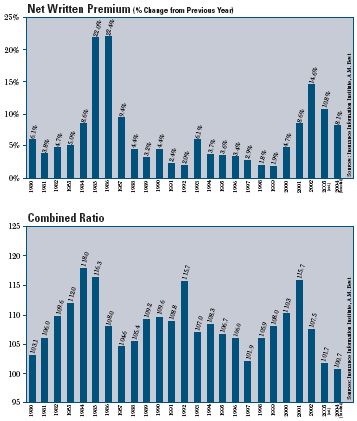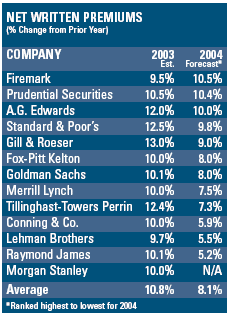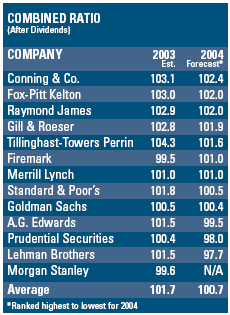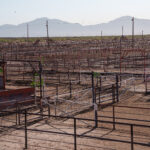Each year the Insurance Information Institute invites a panel of Wall Street stock analysts and industry professionals to review the prospects for the industry in the current and coming year. The survey reveals that the industry’s unrelenting streak of bad luck finally came to an end in 2003 and that another solid year is in store for 2004.
Premium growth, while decelerating, will remain relatively strong. However, the survey also reveals a curious split in the analyst community over the pace of growth in the industry in 2004, with some analysts forecasting a much sharper deceleration in growth than others.
Another bright spot for insurers is the recovery in the investment environment. Taken together, insurers could experience a rare “Goldilocks” market in 2004—a brief period of time when everything is just right.
Strong growth, but easing expected
The average forecast calls for an increase in net written premiums of 8.1 percent in 2004, resulting chiefly from increased prices but to an increasing extent from higher demand as the economic recovery continues to gather steam. While the increase is high by recent historical standards (growth in net written premiums averaged just 3.4 percent from 1990 through 2000), it represents a material deceleration from the 10.8 percent average gain estimated for 2003 and the 14.6 increase realized in 2002.
A hard market in 2004: For and against
The end of double-digit premium growth in the current cycle—as is predicted in 2004—would at first appear to be an ominous sign for the P/C industry in the year ahead. But the hard market cannot be measured by the change in premium growth alone. Indeed, return on equity in 2004 is likely to soar above double-digits for the first time since 1997 because underwriting performance is expected to continue to improve and because the investment environment should allow for the realization of significant capital gains as well as higher investment yields on the industry’s bond portfolio (which accounts for two-thirds of insurers’ invested assets).
All of this is a far cry from recent experience. Lowlights over the past six years included the slowest period of premium growth in the post-World War II era (1.8 percent in 1998 and 1.9 percent in 1999) , the industry’s first-ever net loss (-$6.5 billion) and worst-ever financial performance in 2001 (ROE of -1.6 percent) and record adverse reserve development of $22.7 billion in 2002.
Combined ratio’s slow march downhill
The combined ratio, which is the ratio of losses and expenses to premiums, for 2004 is projected to be 100.7, down from an estimated 101.7 in 2003 and well below the terrorism-impacted 115.7 result in 2001.
While the results show continued improvement, the bottom line is that the industry will still be paying out roughly $1.01 or $1.02 for very $1 it takes in, assuming no major insured losses from terrorist acts in 2004 and “normal” catastrophe activity.
From perfect storm to Goldilocks
Rising prices and tougher underwriting are at the core of the industry’s current recovery, but the industry’s voyage toward recovery has proved to be exceptionally slow, difficult and dangerous, despite price and underwriting discipline. A confluence of events conspired to form a “perfect storm” that battered the industry for five years and pushed insolvency rates and guarantee fund payouts to record highs by 2002.

Elements of that perfect storm included: unrestrained jury awards, surging asbestos claims, soaring medical inflation, high catastrophe losses, the crisis in corporate governance, loss of critical capacity, a weak investment environment, the sluggish economy and, of course, the extreme risk of terrorist attacks.
Needless to say, not all of these problems have been completely vanquished.
Yet despite the lingering storm clouds, Goldilocks might well pay a visit to the P/C industry in 2004. Pricing will neither be too high nor too low and business and consumer demand for insurance will generally be met with relatively few areas of acute shortage.
Interest rates will rise but not too quickly, lest bond prices fall too much. For the icing on the cake, the expanding economy ensures that exposure growth will accelerate—meaning that insurers will at least have some opportunity to compete for new business rather than resort to destructive price wars with each other for the same old business.

What are the biggest potential downside risks for 2004? High on the list is a loss of pricing and underwriting discipline, or, at minimum, a sharp loss of pricing momentum as underwriting performance targets are realized. This concern likely explains the disparity among analyst forecasts for net written premium growth in 2004, which range from 5.2 percent on the low end to as much as 10.5 percent on the high side.
Financial strength also remains a matter of concern. Downgrades still far outnumber upgrades. Given the mature stage of the current cycle, upgrades should be the order of the day.

The failure of tort and asbestos reform legislation was easily the industry’s biggest disappointment in 2003. According to a recent study by Tillinghast-Towers Perrin, tort costs jumped $27.4 billion, or 13.3 percent, to $233 billion in 2002 (representing 2.23 percent of GDP or $809 per capita). Insurers’ share of those costs totaled $165.8 billion, excluding medical malpractice. Controlling these costs will enhance insurer performance and the stability of casualty coverages. For this reason, tort and asbestos reform will be high on the industry’s agenda in 2004.
Robert P. Hartwig is chief economist for the Insurance Information Institute, based in New York City.
Was this article valuable?
Here are more articles you may enjoy.


 Senators Launch Probe Into Demotech’s Ratings in Florida
Senators Launch Probe Into Demotech’s Ratings in Florida  More US Beef Plants May Close as Cattle Herds Keep Tightening
More US Beef Plants May Close as Cattle Herds Keep Tightening  Former CEO of Nonprofit P/C Statistical Agent Sentenced for Stealing Millions
Former CEO of Nonprofit P/C Statistical Agent Sentenced for Stealing Millions  UPS Ripped Off Seasonal Workers With Unfair Pay Practices, Lawsuit Alleges
UPS Ripped Off Seasonal Workers With Unfair Pay Practices, Lawsuit Alleges 


